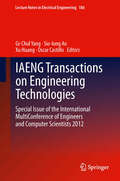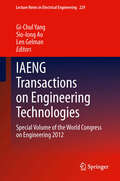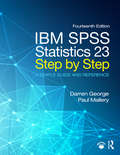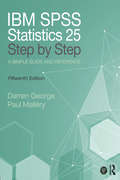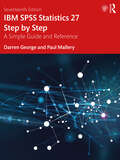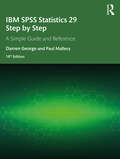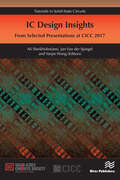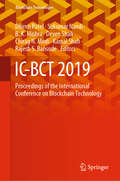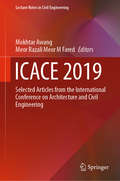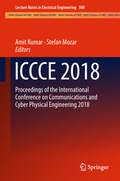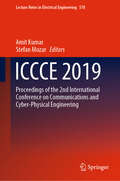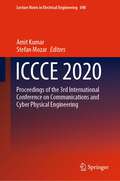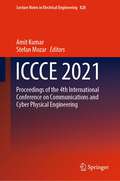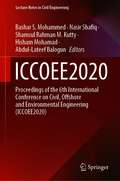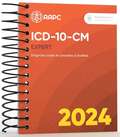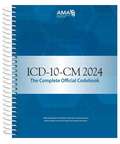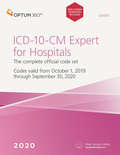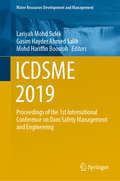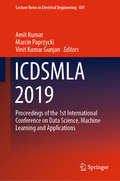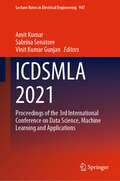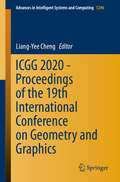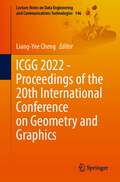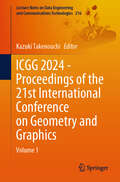- Table View
- List View
IAENG Transactions on Engineering Technologies
by Sio-Iong Ao Oscar Castillo Gi-Chul Yang Xu HuangThis volume contains revised and extended research articles written by prominent researchers participating in the conference. Topics covered include engineering physics, communications systems, control theory, automation, engineering mathematics, scientific computing, industrial engineering, and industrial applications. IAENG Transactions on Engineering Technologies: Special Issue of the International MultiConference of Engineers and Computer Scientists 2012 offers the state of art of tremendous advances in engineering technologies and physical science and applications, and also serves as an excellent reference work for researchers and graduate students working with/on engineering technologies and physical science and applications.
IAENG Transactions on Engineering Technologies
by Len Gelman Gi-Chul Yang Sio-Long AoThis book contains fifty-eight revised and extended research articles written by prominent researchers participating in the Advances in Engineering Technologies and Physical Science conference, held in London, U.K., 4-6 July, 2012. Topics covered include Applied and Engineering Mathematics, Computational Statistics, Mechanical Engineering, Bioengineering, Internet Engineering, Wireless Networks, Knowledge Engineering, Computational Intelligence, High Performance Computing, Manufacturing Engineering, and industrial applications. The book offers the state of art of tremendous advances in engineering technologies and physical science and applications, and also serves as an excellent reference work for researchers and graduate students working on engineering technologies and physical science and applications.
IBM SPSS Statistics 23 Step by Step: A Simple Guide and Reference (14th Edition)
by Darren George Paul MalleryIBM SPSS Statistics 23 Step by Step: A Simple Guide and Reference, 14e, takes a straightforward, step-by-step approach that makes SPSS software clear to beginners and experienced researchers alike. Extensive use of vivid, four-color screen shots, clear writing, and step-by-step boxes guide readers through the program. Exercises at the end of each chapter support students by providing additional opportunities to practice using SPSS. All datasets used in the book are available for download at: https://www.routledge.com/products/ 9780134320250
IBM SPSS Statistics 25 Step by Step: A Simple Guide and Reference
by Darren George Paul MalleryIBM SPSS Statistics 25 Step by Step: A Simple Guide and Reference, fifteenth edition, takes a straightforward, step-by-step approach that makes SPSS software clear to beginners and experienced researchers alike. Extensive use of four-color screen shots, clear writing, and step-by-step boxes guide readers through the program. Exercises at the end of each chapter support students by providing additional opportunities to practice using SPSS. This book covers both the basics of descriptive statistical analysis using SPSS through to more advanced topics such as multiple regression, multidimensional scaling and MANOVA, including instructions for Windows and Mac. This makes it ideal for both undergraduate statistics courses and for postgraduates looking to further develop their statistics and SPSS knowledge. New to this edition: Updated throughout to SPSS 25 Updated / restructured material on: Chart Builder; Univariate ANOVA; moderation on two- and three-way ANOVA; and Factor Analytic Techniques (formerly Factor Analysis structure) New material on computing z and T scores, and on computing z scores within descriptive statistics Clearer in-chapter links between the type of data and type of research question that the procedure can answer Updated / additional datasets, exercises, and expanded Companion Website material, including Powerpoint slides for instructors
IBM SPSS Statistics 26 Step by Step: A Simple Guide and Reference
by Darren George Paul MalleryIBM SPSS Statistics 26 Step by Step: A Simple Guide and Reference, sixteenth edition, takes a straightforward, step-by-step approach that makes SPSS software clear to beginners and experienced researchers alike. Extensive use of four-color screen shots, clear writing, and step-by-step boxes guide readers through the program. Output for each procedure is explained and illustrated, and every output term is defined. Exercises at the end of each chapter support students by providing additional opportunities to practice using SPSS. This book covers the basics of statistical analysis and addresses more advanced topics such as multi-dimensional scaling, factor analysis, discriminant analysis, measures of internal consistency, MANOVA (between- and within-subjects), cluster analysis, Log-linear models, logistic regression and a chapter describing residuals. Back matter includes a description of data files used in exercises, an exhaustive glossary, suggestions for further reading and a comprehensive index. IMB SPSS Statistics 26 Step by Step is distributed in 85 countries, has been an academic best seller through most of the earlier editions, and has proved invaluable aid to thousands of researchers and students. New to this edition: Screenshots, explanations, and step-by-step boxes have been fully updated to reflect SPSS 26 How to handle missing data has been revised and expanded and now includes a detailed explanation of how to create regression equations to replace missing data More explicit coverage of how to report APA style statistics; this primarily shows up in the Output sections of Chapters 6 through 16, though changes have been made throughout the text.
IBM SPSS Statistics 27 Step by Step: A Simple Guide and Reference
by Darren George Paul MalleryIBM SPSS Statistics 27 Step by Step: A Simple Guide and Reference, seventeenth edition, takes a straightforward, step-by-step approach that makes SPSS software clear to beginners and experienced researchers alike. Extensive use of four-color screen shots, clear writing, and step-by-step boxes guide readers through the program. Output for each procedure is explained and illustrated, and every output term is defined. Exercises at the end of each chapter support students by providing additional opportunities to practice using SPSS. This book covers the basics of statistical analysis and addresses more advanced topics such as multidimensional scaling, factor analysis, discriminant analysis, measures of internal consistency, MANOVA (between- and within-subjects), cluster analysis, Log-linear models, logistic regression, and a chapter describing residuals. The end sections include a description of data files used in exercises, an exhaustive glossary, suggestions for further reading, and a comprehensive index. IBM SPSS Statistics 27 Step by Step is distributed in 85 countries, has been an academic best seller through most of the earlier editions, and has proved an invaluable aid to thousands of researchers and students. New to this edition: Screenshots, explanations, and step-by-step boxes have been fully updated to reflect SPSS 27 A new chapter on a priori power analysis helps researchers determine the sample size needed for their research before starting data collection.
IBM SPSS Statistics 29 Step by Step: A Simple Guide and Reference
by Darren George Paul MalleryIBM SPSS Statistics 29 Step by Step: A Simple Guide and Reference, eighteenth edition, takes a straightforward, step-by-step approach that makes SPSS software clear to beginners and experienced researchers alike.Extensive use of four-color screen shots, clear writing, and step-by-step boxes guide readers through the program. Output for each procedure is explained and illustrated, and every output term is defined. Exercises at the end of each chapter support students by providing additional opportunities to practice using SPSS. This book covers the basics of statistical analysis and addresses more advanced topics such as multidimensional scaling, factor analysis, discriminant analysis, measures of internal consistency, MANOVA (between- and within-subjects), cluster analysis, Log-linear models, logistic regression, and a chapter describing residuals. New to this edition is a new chapter on meta-analysis that describes new SPSS procedures for analyzing effect sizes across studies, and the content has been thoroughly updated in line with the latest version of the SPSS software, SPSS 29. The end sections include a description of data files used in exercises, an exhaustive glossary, suggestions for further reading, and a comprehensive index.Accompanied by updated online instructor’s materials and website data files, this is an essential resource for instructors and students needing a guide to using SPSS in their work, across the social sciences, behavioural sciences, education, and beyond.
IC Design Insights - from Selected Presentations at CICC 2017
by Jan Van der Spiegel Ali Sheikholeslami Yanjie WangThis book contains a selection of tutorial and invited presentations that were given at the IEEE CICC 2017 in Austin, Texas. The selection of the talks was made to provide a comprehensive coverage of key topics, including Circuits Techniques for mm-wave front-ends, RF and mm-wave receivers and frequency synthesis, data and DC-DC converters, and techniques for IoT security.The book is organized into five parts, namely:I: Millimeter-wave Transmitter CircuitsII: Millimeter-wave and RF Receiver Circuits III: Data ConvertersIV: DC-DC Converters and Voltage RegulatorsV: IoT Security Circuits and Techniques The book is part of an educational initiative of the IEEE Solid-State Circuits Society to offer its members state of the art educational material.
IC-BCT 2019: Proceedings of the International Conference on Blockchain Technology (Blockchain Technologies)
by Sukumar Nandi Chirag N. Modi Kamal Shah Dhiren Patel B. K. Mishra Deven Shah Rajesh S. BansodeThis book presents articles from the International Conference on Blockchain Technology (IC-BCT) 2019, held in Mumbai, India, and highlights recent advances in the field. It brings together researchers and industry practitioners to show case their ideas linked to business case studies, and provides an opportunity for engineers, researchers, startups and professionals in the field of Blockchain technology to further collaboration.
ICACE 2019: Selected Articles from the International Conference on Architecture and Civil Engineering (Lecture Notes in Civil Engineering #59)
by Mokhtar Awang Meor Razali Meor M FaredThis book presents selected articles from the 3rd International Conference on Architecture and Civil Engineering 2019, held in Kuala Lumpur, Malaysia. Written by leading researchers and industry professionals, the papers highlight recent advances and addresses current issues in the fields of civil engineering and architecture.
ICAF 2019 – Structural Integrity in the Age of Additive Manufacturing: Proceedings of the 30th Symposium of the International Committee on Aeronautical Fatigue, June 2-7, 2019, Krakow, Poland (Lecture Notes in Mechanical Engineering)
by Antoni Niepokolczycki Jerzy KomorowskiThis book gathers papers presented at the 36th conference and 30th Symposium of the International Committee on Aeronautical Fatigue and Structural integrity. Focusing on the main theme of “Structural Integrity in the Age of Additive Manufacturing”, the chapters cover different aspects concerning research, developments and challenges in this field, offering a timely reference guide to designers, regulators, manufacturer, and both researchers and professionals of the broad aerospace community.
ICCCE 2018: Proceedings of the International Conference on Communications and Cyber Physical Engineering 2018 (Lecture Notes in Electrical Engineering #500)
by Amit Kumar Stefan MozarThis book comprises selected articles from the International Communications Conference (ICC) 2018 held in Hyderabad, India in 2018. It offers in-depth information on the latest developments in voice-, data-, image- and multimedia processing research and applications, and includes contributions from both academia and industry.
ICCCE 2019: Proceedings of the 2nd International Conference on Communications and Cyber Physical Engineering (Lecture Notes in Electrical Engineering #570)
by Amit Kumar Stefan MozarThis book is a collection research papers and articles from the 2nd International Conference on Communications and Cyber-Physical Engineering (ICCCE – 2019), held in Pune, India in Feb 2019. Discussing the latest developments in voice and data communication engineering, cyber-physical systems, network science, communication software, image- and multimedia processing research and applications, as well as communication technologies and other related technologies, it includes contributions from both academia and industry.
ICCCE 2020: Proceedings of the 3rd International Conference on Communications and Cyber Physical Engineering (Lecture Notes in Electrical Engineering #698)
by Amit Kumar Stefan MozarThis book is a collection of research papers and articles presented at the 3rd International Conference on Communications and Cyber-Physical Engineering (ICCCE 2020), held on 1-2 February 2020 at CMR Engineering College, Hyderabad, Telangana, India. Discussing the latest developments in voice and data communication engineering, cyber-physical systems, network science, communication software, image and multimedia processing research and applications, as well as communication technologies and other related technologies, it includes contributions from both academia and industry. This book is a valuable resource for scientists, research scholars and PG students working to formulate their research ideas and find the future directions in these areas. Further, it may serve as a reference work to understand the latest engineering and technologies used by practicing engineers in the field of communication engineering.
ICCCE 2021: Proceedings of the 4th International Conference on Communications and Cyber Physical Engineering (Lecture Notes in Electrical Engineering #828)
by Amit Kumar Stefan MozarThis book is a collection of research articles presented at the 4th International Conference on Communications and Cyber-Physical Engineering (ICCCE 2021), held on April 9 and 10, 2021, at CMR Engineering College, Hyderabad, India. ICCCE is one of the most prestigious conferences conceptualized in the field of networking and communication technology offering in-depth information on the latest developments in voice, data, image, and multimedia. Discussing the latest developments in voice and data communication engineering, cyber-physical systems, network science, communication software, image, and multimedia processing research and applications, as well as communication technologies and other related technologies, it includes contributions from both academia and industry. This book is a valuable resource for scientists, research scholars, and PG students working to formulate their research ideas and find the future directions in these areas. Further, it may serve as a reference work to understand the latest engineering and technologies used by practicing engineers in the field of communication engineering.
ICCOEE2020: Proceedings of the 6th International Conference on Civil, Offshore and Environmental Engineering (ICCOEE2020) (Lecture Notes in Civil Engineering #132)
by Bashar S. Mohammed Nasir Shafiq Shamsul Rahman M. Kutty Hisham Mohamad Abdul-Lateef BalogunThis book contains papers presented in the 6th International Conference on Civil, Offshore & Environmental Engineering (ICCOEE2020) under the banner of World Engineering, Science & Technology Congress (ESTCON2020) will be held from 13th to 15th July 2021 at Borneo Convention Centre, Kuching, Sarawak, Malaysia. This proceeding contains papers presented by academics and industrial practitioners showcasing the latest advancements and findings in civil engineering areas with an emphasis on sustainability and the Industrial Revolution 4.0. The papers are categorized under the following tracks and topics of research:1. Resilient Structures and Smart Materials2. Advanced Construction and Building Information Modelling3. Smart and Sustainable Infrastructure4. Advanced Coastal and Offshore Engineering5. Green Environment and Smart Water Resource Management Systems
ICD-10-CM 2024 The Complete Official Codebook with Guidelines
by AapcOfficial 2024 ICD-10-CM Expert Code Book Developed for students and professionals alike, the ICD-10-CM Expert 2024 is designed for coders by coders. It is custom-tailored as an easy, essential reference for use in the office, medical facilities, classrooms, and for exams. The ICD-10-CM Expert 2024 will not only ensure that you’re up to speed with 2024 updates — it will help you check your coding for medical necessity. With color coding and illustrations, you’ll easily navigate, digest and remember the material. Key features and benefits: Complete 2024 ICD-10-CM code set with new codes, new text, revised codes, and revised text Summary of 2024 ICD-10-CM code changes in an easy-to-review appendix 2024 Official Guidelines for Coding and Reporting with quick view flow charts to help students and professional coders meet compliance requirements NEW! 2024 Chapter-specific guidelines before each chapter so you can quickly reference the guidelines you need for the codes you use most “Eye” symbols alert clinical coders that a specific code has a guideline reference Anatomy and physiology descriptions before Tabular List chapters provide information pertaining to specific body anatomy and diseases Special color coding throughout to highlight instructional notes, bilateral and unilateral indicators, and other features Symbols and highlights for Medicare code edits to highlight age, sex, manifestation, other specified and unspecified codes Indicators alert medical billers to MACRA codes required for MIPS quality and cost measures reporting Extension “X” symbol to alert coders to the ICD-10-CM placeholder “x” convention Appendix with Z codes for long-term use of drugs Symbol for Z codes used as the first-listed diagnosis Expanded online updates and tips to help you improve accuracy and efficiency Highlighted vertical lines orient the eye to the correct indentation throughout the Index to Diseases and Injuries
ICD-10-CM 2024: The Complete Official Codebook (ICD-10-CM the Complete Official Codebook)
by American Medical AssociationICD-10-CM 2024: The Complete Official Codebook provides the entire updated code set for diagnostic coding, organized to make the challenge of accurate coding easier. This codebook is the cornerstone for establishing medical necessity, correct documentation, determining coverage and ensuring appropriate reimbursement. Each of the 22 chapters in the Tabular List of Diseases and Injuries is organized to provide quick and simple navigation to facilitate accurate coding. The book also contains supplementary appendixes including a coding tutorial, pharmacology listings, a list of valid three-character codes and additional information on Z-codes for long-term drug use and Z-codes that can only be used as a principal diagnosis. Official 2024 coding guidelines are included in this codebook.
ICD-10-CM Expert for Hospitals: The Complete Official Code Set
by Optum360ICD-10-CM Expert for Hospitals: The Complete Official Code Set is your definitive coding resource, combining the work of the National Center for Health Statistics (NCHS), Centers for Medicare and Medicaid Services (CMS), American Hospital Association (AHA), and Optum360 experts to provide the information you need for coding accuracy. <p><p> The International Classification of Diseases, 10th Revision, Clinical Modification (ICD-10-CM), is an adaptation of ICD-10, copyrighted by the World Health Organization (WHO). The development and maintenance of this clinical modification (CM) is the responsibility of the NCHS as authorized by WHO. Any new concepts added to ICD-10-CM are based on an established update process through the collaboration of WHO's Update and Revision Committee and the ICD-10-CM Coordination and Maintenance Committee. In addition to the ICD-10-CM classification, other official government source information has been included in this manual.
ICDSME 2019: Proceedings of the 1st International Conference on Dam Safety Management and Engineering (Water Resources Development and Management)
by Lariyah Mohd Sidek Gasim Hayder Ahmed Salih Mohd Hariffin BoosrohThis book presents peer-reviewed articles from the 1st International Conference on Dam Safety Management and Engineering (ICDSME 2019), organized by the Malaysian National Committee on Large Dams (MYCOLD), Tenaga Nasional Berhad (TNB), Department of Irrigation and Drainage (DID) and Universiti Tenaga Nasional (UNITEN). With the theme “resilient dams for resilient communities,” the conference highlighted the latest developments in the area and provided a platform for researchers and professionals to exchange ideas and to address dam safety and engineering issues with the environment in mind. The topics covered included, but was not limited to, best practices in dam safety, reservoir management, dam health monitoring, risk assessment, emergency management and sustainable dams.
ICDSMLA 2019: Proceedings of the 1st International Conference on Data Science, Machine Learning and Applications (Lecture Notes in Electrical Engineering #601)
by Amit Kumar Vinit Kumar Gunjan Marcin PaprzyckiThis book gathers selected high-impact articles from the 1st International Conference on Data Science, Machine Learning & Applications 2019. It highlights the latest developments in the areas of Artificial Intelligence, Machine Learning, Soft Computing, Human–Computer Interaction and various data science & machine learning applications. It brings together scientists and researchers from different universities and industries around the world to showcase a broad range of perspectives, practices and technical expertise.
ICDSMLA 2021: Proceedings of the 3rd International Conference on Data Science, Machine Learning and Applications (Lecture Notes in Electrical Engineering #947)
by Amit Kumar Vinit Kumar Gunjan Sabrina SenatoreThis book gathers selected high-impact articles from the 3rd International Conference on Data Science, Machine Learning & Applications 2021. It highlights the latest developments in the areas of artificial intelligence, machine learning, soft computing, human–computer interaction and various data science and machine learning applications. It brings together scientists and researchers from different universities and industries around the world to showcase a broad range of perspectives, practices and technical expertise.
ICGG 2020 - Proceedings of the 19th International Conference on Geometry and Graphics (Advances in Intelligent Systems and Computing #1296)
by Liang-Yee ChengThis book covers various aspects of Geometry and Graphics, from recent achievements on theoretical researches to a wide range of innovative applications, as well as new teaching methodologies and experiences, and reinterpretations and findings about the masterpieces of the past. It is from the 19th International Conference on Geometry and Graphics, which was held in São Paulo, Brazil. The conference started in 1978 and is promoted by the International Society for Geometry and Graphics, which aims to foster international collaboration and stimulate the scientific research and teaching methodology in the fields of Geometry and Graphics. Organized five topics, which are Theoretical Graphics and Geometry; Applied Geometry and Graphics; Engineering Computer Graphics; Graphics Education and Geometry; Graphics in History, the book is intended for the professionals, academics and researchers in architecture, engineering, industrial design, mathematics and arts involved in the multidisciplinary field.
ICGG 2022 - Proceedings of the 20th International Conference on Geometry and Graphics (Lecture Notes on Data Engineering and Communications Technologies #146)
by Liang-Yee ChengThis book covers recent achievements on the ever-expanding field of Geometry and Graphics on both analogical and digital fronts, from theoretical investigations to a broad range of applications, new teaching methodologies, and historical aspects. It is from 20th International Conference on Geometry and Graphics (ICGG2022), a series of conference that started in 1978 and promoted by International Society for Geometry and Graphics, which aims to foster international collaboration and stimulate the scientific research and teaching innovations in the multidisciplinary field. The contents of the book are organized in: Theoretical Geometry and Graphics; Applied Geometry and Graphics; Engineering Computer Graphics; Graphics Education; Geometry and Graphics in History, and are intent for the academics, researchers, and professionals in architecture, engineering, industrial design, mathematics, and arts.
ICGG 2024 - Proceedings of the 21st International Conference on Geometry and Graphics: Volume 1 (Lecture Notes on Data Engineering and Communications Technologies #216)
by Kazuki TakenouchiThis three-volume book gathers peer-reviewed papers presented at the 21st International Conference on Geometry and Graphics (ICGG 2024), held in Kitakyushu, Japan, on August 5–9, 2024. The conference started in 1978 and is promoted by the International Society for Geometry and Graphics, which aims to foster international collaboration and stimulate the scientific research and teaching methodology in the fields of Geometry and Graphics. The ICGG 2024 covered the following five topics taken over from ICGG 2022: Theoretical Graphics and Geometry; Applied Geometry and Graphics; Engineering Computer Graphics; Graphics Education; Geometry and Graphics in History, to which a Related Topic section was added in response to the growing body of research on Geometry and Graphics. Volume 1 collects papers on three of these topics: Theoretical Graphics and Geometry, Graphics Education, and Related Topics. Given its breadth of coverage, the book introduces engineers, architects, and designers interested in computer applications, graphics, and geometry to the latest advances in the field, with a particular focus on science, the arts, and mathematics education.
